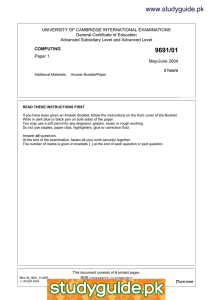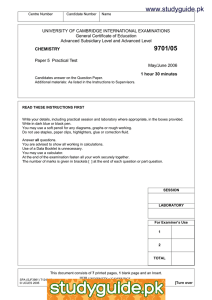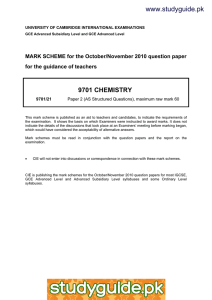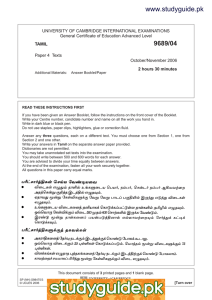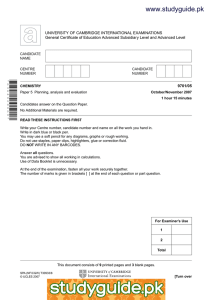www.studyguide.pk UNIVERSITY OF CAMBRIDGE INTERNATIONAL EXAMINATIONS General Certificate of Education Advanced Level 9701/53
advertisement
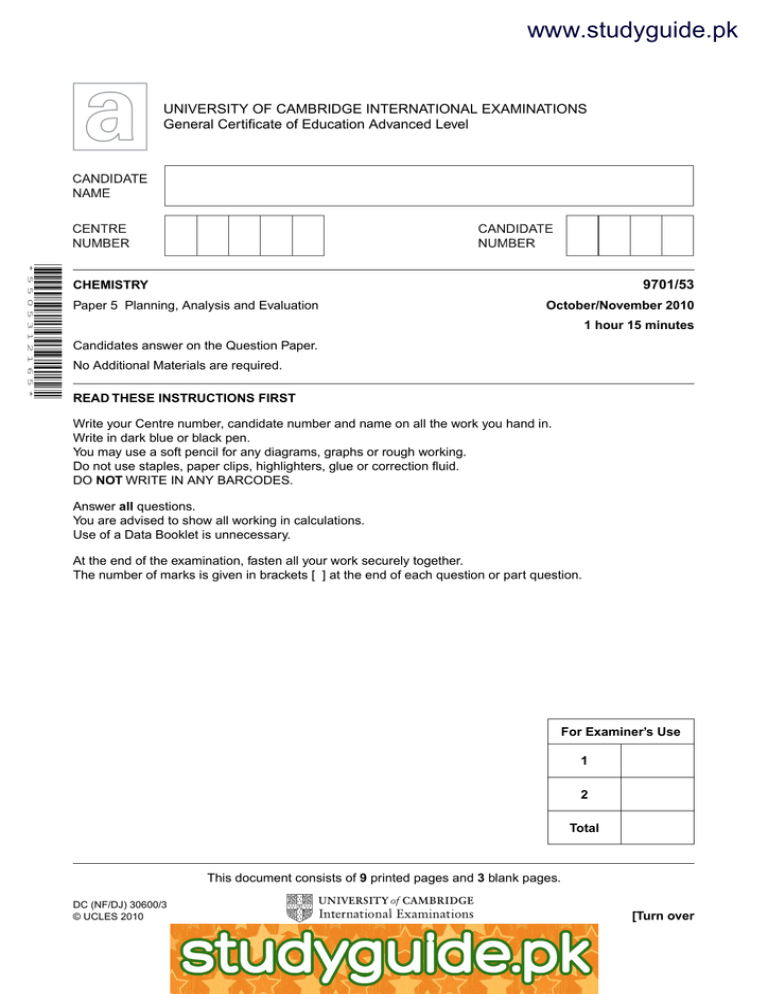
www.studyguide.pk UNIVERSITY OF CAMBRIDGE INTERNATIONAL EXAMINATIONS General Certificate of Education Advanced Level * 5 5 0 5 3 1 2 1 6 5 * 9701/53 CHEMISTRY Paper 5 Planning, Analysis and Evaluation October/November 2010 1 hour 15 minutes Candidates answer on the Question Paper. No Additional Materials are required. READ THESE INSTRUCTIONS FIRST Write your Centre number, candidate number and name on all the work you hand in. Write in dark blue or black pen. You may use a soft pencil for any diagrams, graphs or rough working. Do not use staples, paper clips, highlighters, glue or correction fluid. DO NOT WRITE IN ANY BARCODES. Answer all questions. You are advised to show all working in calculations. Use of a Data Booklet is unnecessary. At the end of the examination, fasten all your work securely together. The number of marks is given in brackets [ ] at the end of each question or part question. For Examiner’s Use 1 2 Total This document consists of 9 printed pages and 3 blank pages. DC (NF/DJ) 30600/3 © UCLES 2010 [Turn over www.XtremePapers.net www.studyguide.pk 2 BLANK PAGE © UCLES 2010 9701/53/O/N/10 www.XtremePapers.net www.studyguide.pk 3 1 Aqueous hydrogen peroxide decomposes into oxygen gas and water. The reaction is normally very slow but is catalysed by solid manganese(IV) oxide. 2H2O2(aq) 2H2O(l) + For Examiner’s Use O2(g) You are to plan an experiment to investigate how the rate of the catalysed decomposition of aqueous hydrogen peroxide depends on its concentration. (a) The rate of decomposition depends on the number of hydrogen peroxide molecules present in a given volume of solution. (i) Use this information to predict and explain how the rate of decomposition of the hydrogen peroxide depends on the concentration. Prediction ................................................................................................................. ............................................................................................................................................... ............................................................................................................................................... Explanation .............................................................................................................. .................................................................................................................................. .................................................................................................................................. (ii) Display your prediction in the form of a sketch graph below. rate / s–1 0 0 [ H2O2 ] / mol dm–3 [3] © UCLES 2010 9701/53/O/N/10 www.XtremePapers.net [Turn over www.studyguide.pk 4 (b) An approximate method for the determination of the rate of decomposition of the hydrogen peroxide is to measure the time taken to collect a fixed volume of oxygen. The volume is kept the same throughout a series of experiments. The rate of the reaction can be represented by the reciprocal of the time taken. Rate of reaction ∝ 1 / time taken In the experiment you are about to plan identify the following. (i) the independent variable .......................................................................................... (ii) the dependent variable ........................................................................................ [2] (c) Draw a diagram of the apparatus you would use in the experiment. Your apparatus should use only standard items found in a school or college laboratory and show clearly the following (i) how the volume of the oxygen will be collected and measured, (ii) how you will make sure that none of the oxygen is lost. Label each piece of apparatus used, indicating its size or capacity. [3] © UCLES 2010 9701/53/O/N/10 www.XtremePapers.net For Examiner’s Use www.studyguide.pk 5 (d) Using the apparatus shown in (c) design a laboratory experiment to test your prediction in (a). For Examiner’s Use In addition to the standard apparatus present in a laboratory you are provided with the following materials. • • 2.00 mol dm–3 aqueous hydrogen peroxide a supply of manganese(IV) oxide (i) Complete the table below to show how you would prepare five solutions of aqueous hydrogen peroxide. Make sure that the correct units are recorded. expt. No. volume of H2O2 volume of H2O concentration of H2O2 1 2 3 4 5 (ii) Give a step-by-step description of how you would use your apparatus shown in (c) to carry out one complete experiment. .................................................................................................................................. .................................................................................................................................. .................................................................................................................................. .................................................................................................................................. .................................................................................................................................. .................................................................................................................................. .................................................................................................................................. .................................................................................................................................. ............................................................................................................................. [4] © UCLES 2010 9701/53/O/N/10 www.XtremePapers.net [Turn over www.studyguide.pk 6 (e) State a problem which might be experienced by someone having to carry out these experiments alone. .......................................................................................................................................... ..................................................................................................................................... [1] (f) Draw a table with appropriate headings to show the data you would record when carrying out your experiments and the values you would calculate in order to construct a graph to support or reject your prediction in (a). The headings should include appropriate units. [2] [Total: 15] © UCLES 2010 9701/53/O/N/10 www.XtremePapers.net For Examiner’s Use www.studyguide.pk 7 BLANK PAGE © UCLES 2010 9701/53/O/N/10 www.XtremePapers.net [Turn over www.studyguide.pk 8 2 When a solute is added to two solvents, A and B, which do not mix, some of the solute dissolves in each of the solvents and an equilibrium is set up between the two solvents. At equilibrium the ratio of the two concentrations is a constant known as the Partition Coefficient, K. concentration in solvent A concentration in solvent B = K An experiment was carried out to determine K for succinic acid, HO2CCH2CH2CO2H, between water (boiling point 100 °C) and diethyl ether, (C2H5)2O, (boiling point 35 °C). • 100 cm3 of distilled water and 100 cm3 of diethyl ether were transferred to a conical flask. • A sample of succinic acid was added, the flask was stoppered and the mixture thoroughly shaken until all of the solid had dissolved. • A 10.0 cm3 sample of the water layer was removed and titrated with 0.10 mol dm–3 aqueous sodium hydroxide using phenolphthalein as an indicator. • A 25.0 cm3 sample of the diethyl ether layer was removed and a small amount of water added. This was then titrated with 0.020 mol dm–3 aqueous sodium hydroxide using phenolphthalein as an indicator. • The experiment was repeated using the same volumes of water and diethyl ether but decreasing masses of succinic acid. (a) The results of the series of titrations are recorded below. A B C expt. No. volume of 0.10 mol dm–3 NaOH reacting with 10.0 cm3 of the water layer / cm3 volume of 0.020 mol dm–3 NaOH reacting with 25.0 cm3 of the ether layer / cm3 1 24.3 18.6 2 22.5 17.3 3 20.3 15.6 4 18.8 13.1 5 16.3 12.5 6 13.8 10.6 7 10.3 7.9 8 6.8 6.9 9 5.0 3.8 10 2.5 1.9 D E Process the results in the table to calculate the concentration of the succinic acid in each layer. Record these values to three significant figures in the additional columns of the table. Label each column, including units and an expression to show how your values are calculated. You may use the column headings A to E in your expression. [3] © UCLES 2010 9701/53/O/N/10 www.XtremePapers.net For Examiner’s Use www.studyguide.pk 9 (b) Present the concentration of the succinic acid in each layer in graphical form. Draw the line of best fit. © UCLES 2010 9701/53/O/N/10 www.XtremePapers.net [3] [Turn over www.studyguide.pk 10 (c) Circle on the graph any point(s) you consider to be anomalous. For any point circled on the graph suggest an error in the conduct of the experiment that might have led to this anomalous result. .......................................................................................................................................... .......................................................................................................................................... .......................................................................................................................................... .......................................................................................................................................... .......................................................................................................................................... .......................................................................................................................................... .......................................................................................................................................... ..................................................................................................................................... [3] (d) (i) Determine the value of K from your graph. Mark clearly on the graph any construction lines and show clearly in your calculation how the intercepts were used in the calculation of the slope. (ii) By considering the data you have processed and the graph you have drawn, decide if the experimental procedure described is suitable for the determination of the Partition Coefficient, K. Explain your reasoning. [3] (e) In the experimental procedure a small volume of water was added to the diethyl ether prior to the titration with aqueous sodium hydroxide. The flask was constantly shaken during the titrations. What was the purpose of this technique? .......................................................................................................................................... .......................................................................................................................................... ..................................................................................................................................... [1] © UCLES 2010 9701/53/O/N/10 www.XtremePapers.net For Examiner’s Use www.studyguide.pk 11 (f) Using a burette, the error associated with a titration depends on the value of the titre. Comment on the magnitude of the titres recorded in the table in (a) and indicate, with reasons, which have the highest error. .......................................................................................................................................... .......................................................................................................................................... ..................................................................................................................................... [2] [Total: 15] © UCLES 2010 9701/53/O/N/10 www.XtremePapers.net For Examiner’s Use www.studyguide.pk 12 BLANK PAGE Permission to reproduce items where third-party owned material protected by copyright is included has been sought and cleared where possible. Every reasonable effort has been made by the publisher (UCLES) to trace copyright holders, but if any items requiring clearance have unwittingly been included, the publisher will be pleased to make amends at the earliest possible opportunity. University of Cambridge International Examinations is part of the Cambridge Assessment Group. Cambridge Assessment is the brand name of University of Cambridge Local Examinations Syndicate (UCLES), which is itself a department of the University of Cambridge. © UCLES 2010 9701/53/O/N/10 www.XtremePapers.net




